The 2014 BPI Awards: Recognizing Excellence in Bioprocessing
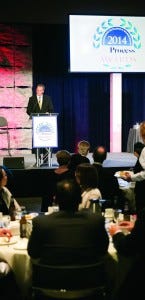 The mission of the BioProcess International publication has always been to deliver valuable industry information to the biotechnology community to continue on the path of scientific advancements, revolutionary technological applications, and strategic partnerships and collaborations. We are honored to cover this market and work with the many talented people sharing their expertise and projects. Now is the time for us to recognize and honor the outstanding people, organizations, and technologies that have significantly influenced and advanced the efficiency of biotherapeutic development and manufacturing processes, ultimately allowing the industry to deliver better, more effective treatments to a global patient base.
The mission of the BioProcess International publication has always been to deliver valuable industry information to the biotechnology community to continue on the path of scientific advancements, revolutionary technological applications, and strategic partnerships and collaborations. We are honored to cover this market and work with the many talented people sharing their expertise and projects. Now is the time for us to recognize and honor the outstanding people, organizations, and technologies that have significantly influenced and advanced the efficiency of biotherapeutic development and manufacturing processes, ultimately allowing the industry to deliver better, more effective treatments to a global patient base.
In January 2014, BioProcess International opened nominations to the industry through a secure online site. Nominations remained open through 18 July 2014. Each submitted nomination was transferred to an individual ballot form. We consolidated those ballots by category and electronically sent them to the judges we had selected based upon their unique expertise. Each judge scored the separate narratives (answers to four or five questions, depending on the category) in a ballot on a scale from 1 (low) to 5 (high) and then selected an overall score for the entry, which was used to break any ties. To confirm impartiality, each judge submitted a signed statement that he or she had scored the nominations fairly and impartially according to the set guidelines.
We thank our panel of judges for their time and thorough review. This year’s panel of judges represented leading corporations and organizations:
Atheln, Inc. | Johnson & Johnson |
Bioproduction Group | Janssen R&D, LLC |
BTEC | MassBiologics |
BioProcess Institute | Primus Consulting |
Complya Asia Co., Ltd. | PDA |
Cleanroom Consulting | Pfizer, Inc. |
Chamow & Associates | Roker Technologies |
Eli Lilly and Co. | University of Birmingham |
2014 BPI Awards Judges Roger Brunkow (independent consultant) |
Excellence in Leadership
This award recognizes an individual who has shown excellent leadership skills. The finalists’ achievements have established them as strong leaders and/or mentors. Key leadership skills have allowed them to successfully help their businesses achieve operational excellence, demonstrate strong visions to drive their companies to greater commercial success, and motivate their teams for growth and innovation.
The winner is Robert Preti, founder and chief scientific officer of Progenitor Cell Therapy (PCT). Preti is recognized as a primary driver of his company’s successful evolution into a leader in the cell therapy manufacturing industry. He oversees all PCT business functions as well as the scientific, engineering, and technical staff and programs. Preti also serves in a leadership capacity for many professional organizations, including the International Society for Cellular Therapy (ISCT) and the Alliance for Regenerative Medicine (ARM). He recently completed a five-year term as a director for the American Association of Blood Banks (AABB).
Justification: Preti founded PCT to meet a recognized need for high-quality development and manufacturing services in an emerging industry. One of Preti’s greatest achievements is building PCT in a way that keeps pace with the industry’s explosive growth and evolving needs. As the field has evolved, so too has PCT. Preti brings a keen insight to his leadership that recognizes the current state of affairs in the industry, where it has been, and where it is going. That is evidenced by his commitment to developing strategies that will result in success for the industry as a whole, not just for PCT. A prime example is Preti’s vision for his company’s Engineering and Innovation Center, which focuses on the developing new technological innovations that will help streamline and automate many cell-processing techniques, leading to faster scale-up, lower cost of goods, and improved robustness in manufacturing for the industry.
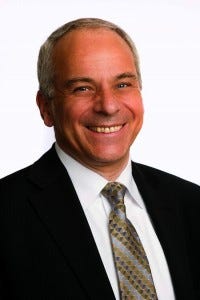
Robert Preti
From the Recipient: Although Preti was unable to attend the awards ceremony, he sent the following comments: “I am truly honored to have been selected as a recipient of the BioProcess International 2014 Excellence in Leadership Award. At PCT, we pride ourselves on helping our clients to be forward thinking — looking ahead with an eye toward the commercialization of cell therapies with a focus on reliability and product quality. I would also like to thank BioProcess International for holding this award series to acknowledge all the hard work of individuals and companies across many areas, including corporate citizenship and facility design. This award series helps remind us all that we are working toward, to quote BPI, ‘allowing the industry to deliver better, more effective treatments to a global patient base.’”
Emerging Company
This award recognizes companies to watch in the industry. Each finalist has a new technology that is already seeing significant industry adoption or has created a technology through an innovative business or partnering model that is worthy of emulation. The finalists have raised awareness within the scientific community and continue to do so.

Satish Nadig and Ann-Marie Broome accepting for ToleRaM from BPI editor in chief, Anne Montgomery
The winner is ToleRaM Nanotech for its work with targeted delivery of immunosuppressant drugs. Nearly half a million people are on dialysis, and more than 100,000 are on the transplant waiting list in the United States alone. Immunosuppressant medications are necessary to keep patients from rejecting newly transplanted organs — at the cost of harmful and sometimes fatal side effects. Current systemic delivery of immunosuppressive drugs compromises a patient’s immune system, creating a condition analogous to immunodeficiency. Severe side effects range from opportunistic infections to development of cancer. ToleRaM Nanotech proposes a novel delivery device wherein nanocarriers filled with immune-modulating drugs are targeted to a transplanted organ.
Justification: Although systemic immunosuppression is necessary for graft survival, the systemic side effects are severe, with effects ranging from opportunistic infections to development of cancer. Through a collaboration of three cofounders spanning the fields of transplant surgery, bioengineering, and immunology, ToleRaM Nanotech was developed as a platform to synthesize and market novel delivery devices that encapsulate antirejection drugs in biologically inert nanoparticles and delivered in a focused way to transplanted organs for triggered release. Whereas current practice uses systemic immunosuppression to modulate a recipient’s immune system, the devices marketed by ToleRaM capitalize on a growing appreciation that immune suppression at the graft level may have more profound effects on rejection while sparing recipients from the complications of systemic immunosuppression.
From the Recipient: Satish Nadig (chief medical officer, assistant professor of surgery, microbiology and immunology at ToleRaM Nanotech) and Ann-Marie Broome, PhD (chief executive officer of ToleRaM Nanotech and professor of radiology at Medical University of South Carolina) accepted for ToleRaM. “One of the capabilities that was important to us was being able to look around in our environment and seeing what’s available, what people’s expertises were, and to see what we are passionate about,” said Nadig. “We did not take ‘no’ for an answer. We combined all those factors in a combined team- science approach to push forward our passion and make something available to patients and healthcare professionals that incorporates multiple disciplines.”
Broome added, “We offer a platform that is much like building blocks. So we can change the targeting delivery, change the component composition, and change the interior drug to expand it. It becomes, not a one-trick pony, but a whole stable of thoroughbreds.”
Corporate Citizenship
This award recognizes a company that has made significant contributions through activities within a broader urban or regional community. Through the involvement of their employees, the finalists are well respected for their significant achievements within their local communities and in that broader context, to the world at large.
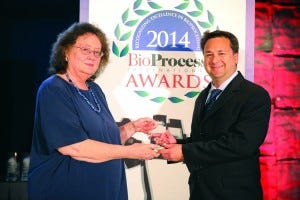
Albert Obrero accepting for Bayer Healthcare
The winner is Bayer HealthCare for its expertise in science, business, and innovation to building healthy lives and sustainable communities. At all levels of the company, philanthropy and community involvement are a critical part of Bayer’s culture. When the company chose to move its global biotech headquarters to the San Francisco Bay Area in 1992, community benefits were written into its 30-year development agreement with the city of Berkeley, CA. Their groundbreaking agreement went beyond the standard development mitigations to meeting broad community needs for resource reduction, recycling plans, automobile use reduction, child care, affordable housing, high-quality public education, and an array of other initiatives. This comprehensive strategy represents a high level of commitment from Bayer, including a significant financial investment totaling more than US$20 million to date. Leadership in workforce development, climate protection, and patient support are necessary for business and demonstrate the company’s commitment to building trust with surrounding communities and employees.
Justification: As a business leader, Bayer works to develop programs and policies that advance workforce development in the fields of science, technology, engineering, and math (STEM). Bayer employees are actively engaged in their communities in a variety of ways. The company works with government officials on key issues including improvements to education, workforce preparation, and economic development. Community engagement is a central component of Bayer’s corporate culture. Its employees are committed to numerous volunteer initiatives, especially the award-winning “Making Science Make Sense” program, which promotes science education in local schools.
From the Recipient: Albert Obrero (senior project specialist) accepted the award on behalf of Bayer Healthcare. BPI asked him to comment on what corporate citizenship means and how a company benefits from being an active part of its community. He said, “Corporate citizenship means to us that we are heavily involved in our community and that we have been able to set up programs to help youth fulfill their hopes so that they can become scientists as well. Someday, we will be dependent on their expertise. As part of the biotech industry, Bayer Healthcare is not alone in this mission. This is the type of corporate citizenship that we need from other companies as well. One of the things that we do is go to other venues, and we teach separate classes at UC Berkeley and at local schools in Berkeley. We have spent over 20 years with Bayer sites across the United States — and beyond — getting involved with our community and helping youth understand the importance of science and help forefront science education.”
Excellence in Facility Design or Retrofit
This award recognizes an innovative facility or retrofit that is exemplifying innovation through its use of key technologies and/or designs. It provides a high-quality example of energy efficiency, traffic flow (people and materials), conversion to single-use or flexible operations, increased automation, accommodation to local ordinances and integration with local services and policies, expansion to take on a new product line or convert to a multiproduct facility, creation of better ergonomic conditions, and/or many other capabilities. Finalists for this award offer a high standard for facility design and sustainability.
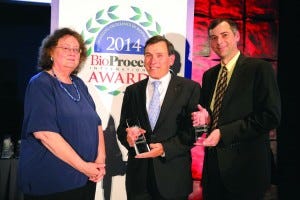
Mike Ultee and Geoff Hodge accepting for Gallus BioPharmaceuticals and GE Healthcare Life Sciences, respectively
The winner is Gallus BioPharmaceuticals with GE Healthcare Life Sciences for a facility in St. Louis, MO. Gallus BioPharmaceuticals is a mammalian cell culture contract development and manufacturing organization. It was established through the May 2011 purchase of a manufacturing facility in St Louis, MO, by CEO Mark Bamforth. The 27-year-old biopharmaceutical manufacturing facility was previously owned by Wyeth, Pfizer, and most recently Johnson & Johnson.
Gallus added to existing traditional development and manufacturing capabilities with the “factory of the future” concept through installation of GE Healthcare Life Sciences’ FlexFactory single-use biomanufacturing platform. This new and expanded capability was successfully achieved in just nine months. Gallus began by stripping back the existing office space to a shell before installing all required elements for a cleanroom environment, including airflow and drainage. FlexFactory equipment was brought in once the construction phase was completed. It gives customers rapid access to current good manufacturing practice (CGMP) manufacturing capacity for key biologics such as monoclonal antibodies and vaccines, from cell culture to bulk product formulation. This extensive application of single-use technology provides the flexibility to modify individual processes when operators need to implement a change or develop a completely new production line for a facility in nine to 12 months.
Justification: In 18 months, the facility has completed 23 successful bioreactors runs for early phase products, for multiple clients. Gallus will be adding some late-phase and manufacturing runs by the end of the year. Four mammalian cell lines have been used in multiple bioreactor runs, demonstrating robust scale-up performance and successful manufacturing of clinical materials. This facility demonstrates the ability to change-over products for improved sustainability and reduced cross-contamination risk with 90% lower water use and a single operating team.
From the Recipients: Mike Ultee (chief science officer, Gallus BioPharmaceuticals) and Geoff Hodge (biomanufacturing services leader, GE Healthcare Life Sciences) accepted the award on behalf of their companies. BPI asked them what this award means to them and what key factors enabled their accomplishment. “To us at Gallus,” said Ultee, “the award is a great support for the kind of innovation that the Xcellerex platform provides. The rapid installation, the versatility, and the flexibility of this system is something that is really working for us.”
Hodge added, “It’s really a close collaboration between Gallus and GE Healthcare around not only the products, but also the service and support, working together as two teams to achieve a very quick facility expansion.”
Best Collaboration
This award recognizes a number of promising collaborations that have been formed in the past 18 months and provided significant benefits toward accelerating drug development or mitigating risks. The finalists have come together to form a solid foundation for innovation and a long-term mission for accelerated growth.
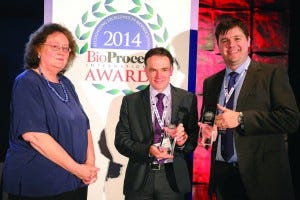
Richard Wales and Christopher Kistler accepting for TAP Biosystems (now part of Sartorius Stedim Biotech) and Merck
The winners are TAP Biosystems (now part of Sartorius Stedim Biotech) and Merck for their collaboration to develop a dual-use, fully automated, highly parallel bioreactor system capable of enabling a single scientist to execute a statistical design of experiments (DoE) project across 24 single-use bioreactors. The collaboration brought together highly knowledgeable teams of people: Merck brought deep understanding of bioprocessing and biopharmaceutical development, and TAP provided extensive automation and manufacturing experience. Both companies worked in true partnership despite the fact that this was a vendor–customer collaboration. This cooperation was based on a fully transparent relationship, allowing participants to highlight challenges and overcoming them together as a single team. Flexibility, honesty, and communication played a key role in the successful completion of this project, developing a highly functional product that is based on specific customer needs. That is reflected by its wide placement across the industry.
Justification: This collaboration resulted in development of a bioreactor system that is highly innovative and the first of its kind in the bioprocess industry. Merck and TAP worked in collaboration from design concept through development and into launch, ensuring that real customer needs were always a priority. The system was developed to meet specific needs, including those for high throughput, ease of use, increased consistency, and improved accuracy. To highlight utility of the output of this collaboration to the larger bioprocess community, TAP Biosystems has received very good feedback from external users regarding the efficiency benefits of using the ambr250 system. In addition, the business relationship between TAP Biosystems and Merck has continued to grow into a long- term strategic partnership. As part of this partnership, Merck often will be involved in prototyping and providing user feedback on many of TAP’s new technologies.
From the Recipients: Richard Wales (business development manager, TAP Biosystems) and Christopher Kistler (principal scientist, Merck & Co.) accepted the award on behalf of their companies. BPI asked them to describe the main objective of the collaboration. “It was a pleasure to work with Richard and TAP Biosystems,” said Kistler. “The objective for us was to make a piece of instrumentation that a scientist could use to get an enriched set of data very quickly in the world of limited resources in which we live.”
Wales added, “Key factors in the successful collaboration for us were finding a good partner to work with on this project and taking the time to really understand its requirements, what it needed, and understand in depth the context into which the system is going. The other part of that is to have a good team behind you.”
Industry Champions
Industry champions are individuals whose clear vision, tireless efforts, unwavering dedication, and tangible actions have uniquely helped BioProcess International effectively educate the industry. In doing so, industry champions challenge the industry never to accept the status-quo and never to doubt, give up, or give in. They continually strive to rethink, reinvent, and create new ways to improve existing processes, products, and technologies. In 2014, BioProcess International is proud to honor two industry champions: Lee Buckler and James Vogel. Their ongoing work and commitment to excellence exemplify our definition of industry champion.
Lee Buckler, Founder and Managing Director, Cell Therapy Group: There is little doubt regarding the promise and potential of cell therapies. But the biopharmaceutical industry understands how difficult the road from promise to fulfillment can be. Often, the difference between success — or the ability to continue development — and ultimate failure comes from a lack of the right training and/or education or an inability to clearly communicate results or the “big picture.” Lee Buckler has made it his personal mission to do exactly this: to educate the industry, communicating the vision of cell therapies and ensuring that such game- changing technologies have the best opportunities to succeed.
In 2009, Buckler was instrumental in helping to shape and steer BPI’s first cell therapy supplement and the BPI theater series. He has worked with us closely ever since. As a long-time member of BPI’s editorial advisory board, he has written for us frequently and recommends authors for our continued explorations of regenerative medicines. In fact, he has worked with more than 45 cell therapy and regenerative medicine groups and associations, and in addition to writing for BioProcess International, has been published more than 50 times. Buckler has worked with and provided guidance to several conference companies to help create, organize, and breathe life into numerous cell therapy industry meetings that may owe their continued existence to his efforts. He is on the advisory boards of several organizations. His tireless work in social media also provides the cell therapy industry with much needed information and perspective.
Buckler started his career with a BEd degree in social services from the Canadian University College in 1990. He earned his law degree from the University of British Columbia in 1995. His cell therapy career began as business development manager at Malachite Management, and since then he has held management roles at both nonprofit organizations and commercial cell therapy companies. In 2008, Buckler founded The Cell Therapy Group to help meet the demands for business-focused services within the cell therapy and regenerative medicine industries. Throughout his career, he has had the unique ability to make that one extra introduction, to connect like- minded organizations and individuals toward achievement of common goals, and to always recognize and champion the “big picture” of cell therapy. BPI is proud to honor Lee Buckler as a 2014 Industry Champion.
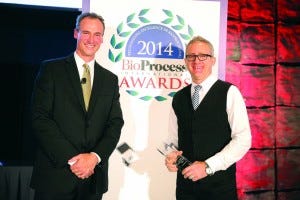
BPI publisher Brian Caine and Lee Buckler
From Lee Buckler: “Thank you to BPI for this award. To be described as an ‘industry champion’ for an industry to which I still feel like I’m trying to prove that I have the stripes to belong, this kind of recognition means everything. More important, however, I accept the award on behalf of the industry. Cell therapy has been my focus since 2000 — although I didn’t realize that it was my passion until about 2005 when I decided that it was this nascent little industry that got me up in the morning more than anything else I’d ever done or was doing. I think that if cell therapy were a human, it would be a ‘tween’: just grown-up enough to occasionally seem like an adult, but still on an emotional roller-coaster of ups and downs, with little predictability and uncertainty about what it’s going to be when it grows up — but its well on its way.
“Although the industry is now attracting an unprecedented amount of investment and attention from large life-science and biopharmaceutical companies, that activity is still modest, and the drivers are still based on future potential not current business. But it is this promise of the potential to use cells as therapeutics to change the way we treat untreatable conditions that gets us all up in the morning and headed to the bench, the clinic, the office, the investor meeting, or whatever we each do to contribute in our own way.
“To champion the cell therapy industry, I’ve used simple, commonly available tools and simply applied an irrational amount of pressure to them. I’ve used Twitter, where I was the lone voice of cell therapy in the early days, but we’ve changed that now. I’ve used LinkedIn, where I started the Cell Therapy Industry Group the day it opened up the ability to form groups. We’re now days away from having 10,000 members, and there are a plethora of other similar groups representing various angles of the industry. I’ve used the BioProcess International publication, pushing them into accepting me on their advisory board before anyone had even coined the phrase cell therapy bioprocessing. I’ve used conferences, lobbying for cell therapy content, then tracks, then entire conferences — until now there is more content than most people can consume.
“BPI was one of the few organizations that stepped up early and said, ‘This may not make good business sense today, but we’ll drink the Koolaid. We believe that there is a future for the cell therapy industry, and we’re going to invest. Having our brand positioned in that space by investing a lot of money is simply doing what we do best: providing content and opportunity for the cross-flow of information, education, and expertise.’ I’ve been thrilled to be small part of that process. I’ve always believed that my success was critically tied to my ability to identify people of whom I could ask stupid questions without a ripple effect from that demonstration of my igorance. I owe a debt of gratitude to the entire industry for letting me tag along, but especially a handful of people who were particularly tolerant of my dumb questions as I learned.”
Whatever It Takes |
James Dean Vogel, PE: In a relatively short period, single-use technologies (SUTs) have entered the mainstream as a critical and essential factor in bioprocessing. With their growth in sophistication and maturation come proprietary concerns, technical and regulatory challenges, and conflicting user expectations. What is a standard? Which guidelines should be followed? Who is responsible for setting them? For which product classes and manufacturing stages are such technologies appropriate? Where are innovations still needed, and why?
At this point, no fewer than eight industry associations are creating and publishing their versions of SUT standards, guidelines, and best practices. The results are yielding a significant body of work, but a clearly unanimous industry standard has yet to emerge. This continuing lack of consensus reflects growing confusion and frustration in the industry, which could ultimately slow or hinder adoption of single-use technologies and limit the innovation necessary to secure their continued growth and maturation. In 2013, Jim Vogel recognized this threat to the continuing adoption of SUTs and made it his personal mission to ensure that the various organizations would not continue to work at cross purposes with one another.
To bring some clarity and structure to the market and try to minimize duplication of effort, Vogel challenged all the groups to come together, find common ground, and educate the industry in one unified voice — all while respecting their individual identities and the integrity of their organizational missions. To pursue his goal, Vogel has organized, facilitated, and moderated multiple panel discussions and meetings (including The Town Hall Forums); conducted teleconferences; and published Single- Use News L-E-T-T-E-R-S, a monthly industry newsletter dedicated to facilitating coordination of SUS standards- and-practice efforts. Each issue reviews and summarizes the groups’ individual progress, reports and establishes their agendas, and announces upcoming presentations and public seminars.
Combine all those efforts, and it becomes clear that Vogel has uniquely positioned himself as a champion of single-use technologies. For these reasons and more, BPI is proud to honor James Vogel as a 2014 Industry Champion.
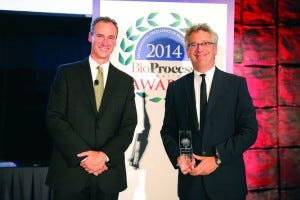
Brian Caine and Jim Vogel
From Jim Vogel: “It is an honor to receive the award from BPI. I’d like to thank Brian, Anne, Chris, Liz, and all the BPI staff. The Single-Use L-E-T-T-E-R-S effort (a.k.a. ‘Alphabet Soup’) started a year ago at the BPI meeting here in Boston. That first meeting was a town hall with the consensus standards and working groups reporting what they are doing with single-use technology. Many attendees knew a little of what the others were doing, but only a few of us were attending more than one meeting. Those of us who were ‘recognized liaisons’ between the organizations would learn about the others when we reported back to our main organization, and someone would say, ‘Are you coordinating with this other organization because they are doing something on that topic too!’ So the groups decided to have a monthly phone call. We started to publish minutes among ourselves. Outside folks from the single-use community asked about the groups, so we made the minutes public, and Single-Use L-E-T-T-E-R-S was born.
“Fast forward to now, a year later. We have had five town hall meetings, five Single-Use L-E-T-T-E-R-S, a joint meeting with the FDA (sponsored by PDA) as a group, and our first planning meeting today. We have created a list of who is working on what, defined the specific work projects, and identified some areas where work is needed to help single-use technologies enable safer and better drugs.
“I’d like to acknowledge the members of the organizations for their efforts and willingness to work together: together: the American Society of Mechanical Engineers’ Bioprocessing Equipment group (ASME-BPE), the American Society of Testing and Materials (ASTM), the Biophorum Operations Group (BPOG), the Bio- Process Systems Alliance (BPSA), Extractables and Leachables Safety Information Exchange (ELSIE), the Parenteral Drug Association (PDA), the Product Quality Research Institute (PQRI), and the United States Pharmacopeia (USP). The concluding remarks from today’s meeting capture the current spirit of this group: ‘We are working together addressing conflict and moving forward toward defined standards for SUT!’ That’s not bad for a year’s effort, and I look forward to continue the progress. Thank you to BioProcess International and the ‘Alphabet Soup’ organizations.”
Upstream Technology Application
This award recognizes a user or supplier of an application that offers much more than hype. The finalists have shown through adoption and application of existing technology or development of their own materials and methods that they are paving the way toward new approaches to process design or new apparatus with well-documented improvement over existing equipment.

Mwai Ngibuini and Christopher Kistler accepting for TAP Biosystems (now part of Sartorius Stedim Biotech) and Merck
The winner is the ambr250 instrument (TAP Biosystems and Merck & Co.), a fully automated, highly parallel bioreactor system that can enable a single scientist to execute a statistical design of experiments (DoE) across 24 single-use bioreactors. The ambr250 technology is both single use and capable of supporting both microbial and mammalian cell culture experiments. The system relies on simple-to-use processes for connecting disposable vessels to gas, feed, and sensor systems. A full suite of automated controls and features, including robotics for sample and liquid handling, drive efficient process development.
Justification: The system is configured for either 12 or 24 parallel bioreactors, each with individual bioreactor temperature and impeller control. It also includes a liquid handler for automated sampling and addition as well as media make-up. The system is enclosed in a Class 2 biological safety cabinet. The ambr250 instrument single- use bioreactors have a novel ‘easy-connect’ design, are fully disposable, and come integrated with filters, pH probes, and dissolved-oxygen (DO) spot sensors. The vessels also have a working volume of 100–250 mL. Workflows are set up and controlled by easy to use, flexible, and intuitive software, which provides precise control of process parameters.
From the Recipients: Mwai Ngibuini (product manager, TAP Biosystems, now part of Sartorius Stedim Biotech) and Christopher Kistler accepted the award for their companies. BPI asked them to describe the driving forces behind the development of the ambr250 instrument. “It’s a fantastic honor to be recognized in collaboration with TAP Biosystems for the ambr250,” said Kistler. “I think that when we went into developmenf of this instrument, we were hoping to show the industry that we had a useful tool that could enrich scientists’ lives as well as get them more data in less time and with fewer resources. Recognition by BioProcess International shows that we have accomplished that task.”
Ngibuini agreed. “The main need that is being fulfilled here is being able to bring drugs quickly to the market, and in that way being customer driven and patient driven. That is the single biggest benefit this technology brings to the industry.”
Kistler concluded, “What the ambr250 brings to scientists is the ability to enrich the data that they have. The system allows researchers to explore variables at the breadth and depth that they hadn’t been able to before with limited resources.”
Downstream Technology Application
This award recognizes a user or supplier of an application that is reducing downstream processing steps and their related time and costs. Strides toward achieving continuous processing regimens and greater efficiency at later stages (even into formulation, fill, and finish) are already transforming the industry’s ability to approach its work more efficiently. Finalists in this category are companies whose new technologies show, though well-documented application, that they are indeed game-changers.
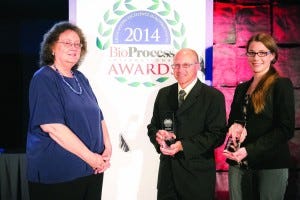
James Stout and Kistina Pleatt accepting for Natrix Separations and Gallus Biopharmaceuticals
The winner is Natrix Separations, Inc. and Gallus BioPharmaceuticals for Natrix HD membranes, a revolutionary chromatographic separation technology and patented three-dimensional macroporous hydrogel structure. It provides a high density of binding sites, which allows for a larger binding capacity than with traditional resin-based columns. The technology does not rely on diffusion, but rather uses advective flow, which improves load distribution and allows up to 25 times higher flow rates than can be achieved with conventional resin-based columns. Natrix HD technology is applied similarly to traditional column chromatography and has the capacity for binding and eluting a broad range of molecules. At Gallus Biopharmaceuticals, the technology is used in downstream processing in the biomanufacture of a variety of protein molecules.
Justification: Gallus’s decision to apply this technology was influenced by its desire to be on the forefront of technologies that can enable the company to offer services and flexible manufacturing options to its biopharmaceutical and biotechnology contract development and manufacturing clients. Using the Natrix HD membrane provided many benefits. In terms of downstream processing, the technology allows for a more dense collection of binding sites and allows for faster flow rates than traditional resin-based columns. It also provides substantial cost savings by eliminating large, fixed glass columns and the associated packing of columns and resin storage that comes with them. Also, it allows for faster batch-to-batch and product-to- product turnover. Finally, the hydrogel matrix is environmentally friendly and does poses no patient risk.
From the Recipients: James Stout (vice president, Process Sciences, Natrix) and Kristina Pleitt (DSP scientist, Gallus Biopharmaceuticals) accepted the award on behalf of their companies. BPI asked them to describe how this technology fits current industry trends. “Our technology is a completely disposable chromatography that did not previously exist in the industry,” said Stout. “It matches very well with existing disposable technology, and it fits well with single-use and flexible facilities, which are upcoming and popular trends these days. We have been working with different collaborators, and we are determining how our technology can benefit the industry in a real way and what the uptake might be for industry and clients to benefit their advanced processing to meet client and patient needs. So we are very proud and happy to receive this award.”
Pleitt adds that “all the Natrix products fit very well in the industry with current trends. We always like to offer our clients flexible solutions that will get them the processing that they need.”
Analytical Technology Application
This award recognizes a user or supplier of an application of analytical methods (old and new), which form the essential foundation of biopharmaceutical and biotherapeutic development at all phases from preformulation to postmarketing. These methods ensure the consistency and reliability of raw-material quality, safety and efficacy of drugs throughout development and all stages of characterization, consistency of product manufactured in different facilities, safety and efficiency of workers, and comparability with previous lots or between biosimilars and innovator products. Finalists in this category have demonstrated increased functionality alone or in novel combinations with other analytical technologies; or they may reveal significant benefit in new applications — including for emerging product sectors.
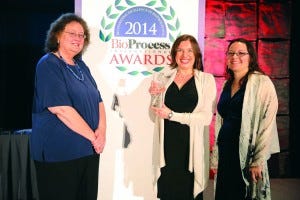
Ann Lazic and Nicole Ford accepting for NanoTemper Technologies
The winner is NanoTemper Technologies GmbH for MicroScale Thermophoresis (MST), which is designed to be an easy, fast, and precise way to quantify biomolecular interactions. It measures the motion of molecules along microscopic temperature gradients and detects changes in their hydration shell, charge, or size. Therefore, binding events can be detected even without an increase in size or mass upon complex formation. This provides for a large application range, from ions and small molecules to high– molecular-weight and multiprotein complexes. Because MST is performed without surface immobilization, it can be used to investigate bulky or sensitive molecule assemblies such as liposomes, nanodiscs, or membrane proteins. Within the Monolith series, the Monolith NT.Automated system is designed for high-throughput applications with the ability to measure 96 samples in parallel. Screening projects can be automated by integrating the instrument into a robot-compatible sample-preparation platform.
Justification: Using the newly developed Monolith NT.Automated instrument, a library containing 193 preselected fragments (provided by Sanofi, Paris) was screened for interactions with the drug target MEK1 kinase. By analyzing the binding of all 193 fragments, the team identified and ranked >70 binders according to their affinities. Seven out of eight previously confirmed hits were among the top 15 fragments and yielded X-ray cocrystal structures with MEK1. Moreover, when the team compared different screening methods, the MST ranking showed a very strong correlation with a qualitative DSF screening. By contrast, surface plasmon resonance (SPR) picked up several false positives, which were easily identified using MST because of their protein aggregating/ denaturating effects. Taken together, high-throughput binding analysis by MST is a valuable tool that complements qualitative screening methods and circumvents false-positive results that are common with other biophysical screening methods.
From the Recipient: Ana Lazic (director of sales and marketing) and Nicole Ford (application scientist) accepted the award on behalf of NanoTemper Technologies GmbH. Lazic said, “MicroScale Thermophoresis is innovative technology that allows measurement of biomolecular interactions in solution in an easy, quick, and efficient way.”
Ford adds, “Our new automated system allows more high-throughput measurements for biopharmaceutical companies for drug screening.”
“We are very excited and honored to receive the BioProcess International award and be so quickly recognized,” concluded Lazic. “And we are thankful to our peers and industry colleagues.”
Sponsors and Industry Partners |
2014 BPI Awards Finalists
Excellence in Leadership
| Excellence in Facility Design or Retrofit
| Best Downstream Technology Application
|
Emerging Company
| Best Collaboration
| Best Analytical Technology Application
|
Corporate Citizenship
| Best Upstream Technology Application
|
Additional information, including photos of all the nominees and videos of the awards presentation can be found on our BPI Awards 2014 webpage.
All photos by Wilton Brothers Photography.
Maribel Rios is managing editor, Cheryl Scott is cofounder and senior technical editor, and S. Anne Montgomery is cofounder and editor in chief of BioProcess International.
You May Also Like





